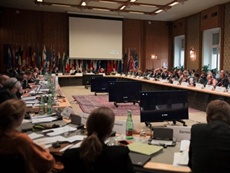India admitted to arms control group Wassenaar Arrangement
08 Dec 2017
India has been admitted to the Wassenaar Arrangement (WA), a group that controls the global trade in conventional weapons and dual-use goods and technologies, as its 42nd member.
 India, which is already a member of the Missile Technology Control Regime (MTCR), is now member of two global arms control regimes. The Wassenaar Agreement is one of the four regimes that govern transfers of potentially dangerous technologies.
India, which is already a member of the Missile Technology Control Regime (MTCR), is now member of two global arms control regimes. The Wassenaar Agreement is one of the four regimes that govern transfers of potentially dangerous technologies.
India is yet to become a member of the nuclear trade control grouping Nuclear Suppliers' Group (NSG) that control trade in nuclear materials and the Australia Group which restricts trade in materials used to make chemical and biological weapons.
The Ambassador of France Alexandre Ziegler tweeted his country`s congratulations. "As president of the Wassenaar Arrangement this year and co-rapporteur of India`s candidacy, France warmly congratulates India for joining the Arrangement.
"One more recognition, after MTCR, of the growing role India plays in today`s world," he said, tagging India's ministry of external affairs, external affairs minister Sushma Swaraj, and French foreign minister Jean-Yves Le Drian.
"Wassenaar Arrangement (WA) participating states reviewed progress of a number of current membership applications and agreed at the plenary meeting to admit India which will become the arrangement`s 42 participating state as soon as the necessary procedural arrangements for joining the WA are completed," the grouping said in a statement.
India's membership of the Wassenaar Arrangement on Export Controls for Conventional Arms and Dual-Use Goods and Technologies comes more than a year after becoming member of the Missile Technologies Control Regime (MTCR).
Russia, France, Germany and the United States have strongly supported India's entry into the group.
Unlike the NSG, China is not a member of the Wassenaar Arrangement and this further strengthened India's case for NSG membership.
China, which has repeatedly blocked New Delhi's bid for membership of the NSG, is holding on to its stance of opposing India's membership in NSG where it has a say.
India had, earlier this year, approved the Special Chemicals, Organisms, Materials, Equipment, and Technologies (SCOMET) items, which is mandatory under the Wassenaar Arrangement. Through the revised list of items, India also seeks to send a message about its larger commitment to non-proliferation.
India's strong candidature was acknowledged on Wednesday by Russia's deputy foreign minister Sergey Ryabkov who said that India is likely to get the membership if everything goes well at the plenary session. "If everything goes as expected, I keep my fingers crossed on Thursday we may see a decision of accepting India into the Wassenaar arrangement, which is also very important export control regime," he said.
The two-day plenary session of the Wassenaar Arrangement regime commenced in Vienna today.
Meanwhile, India has intensified engagement with the two other export control regimes - the Nuclear Suppliers Group (NSG) and the Australia Group.
Established in December 1995, the Wassenaar Arrangement has now emerged as a measure to coordinate and harmonise policies governing exports of arms, dual-use equipment and sensitive technologies.
The regulations are implemented through two lists - the Munitions List which tracks conventional weapons, and the Dual-Use Goods and Technologies List. New members are accepted based on specific criteria, including countries which produce / export arms or associated dual-use goods and technologies; establish national policies that restrict sale of arms and sensitive technologies to countries of concern; and adhere to non-proliferation regimes.
The group also ensures that transfer risks are understood by all member states. This is done by regular exchange of information and reporting arms transfers / denials on a six-monthly basis. In some cases, shorter time-frames are applicable. While the decision to transfer or deny the transfer of any item is the sole responsibility of each State, the group has agreed to a number of guidelines, elements and procedures as a basis for decision-making.
The members meet regularly in Vienna where the Wassenaar Arrangement has established its headquarters and Secretariat.
The Wassenaar Arrangement Plenary is the group's decision-making body. It is composed of representatives of all Participating States and normally meets once a year, usually in December. The position of Plenary Chair is subject to annual rotation among Participating States. For 2017, the Chair is held by France. All Plenary decisions are taken by consensus.






























